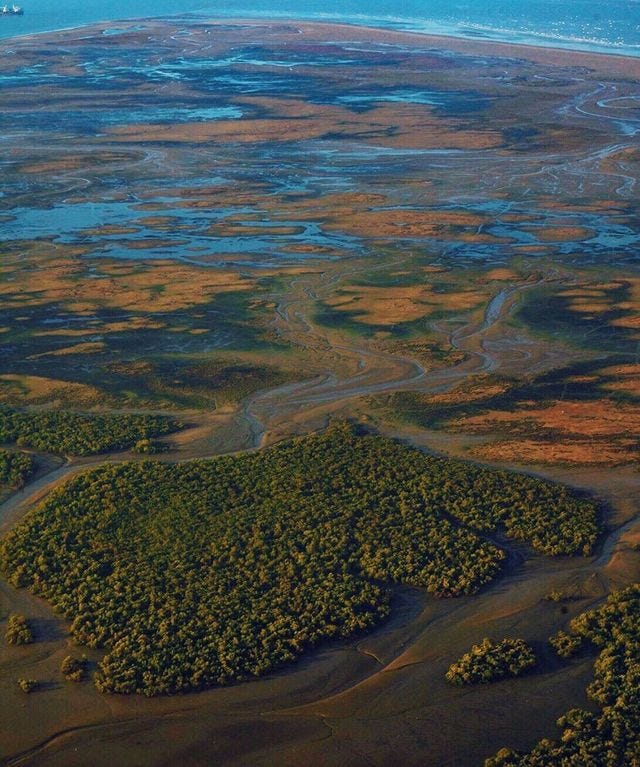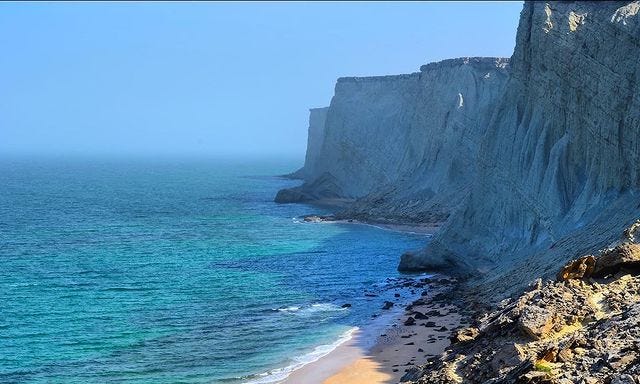Weekly roundup
Hafte ka jaiza
Oct 02, 2020
The Island’s of Pakistan
This week we scoured the inter webs, and found some beautiful islands in Pakistan. This is their story.
Manora

Islands of Pakistan (1/3)
Manora or Manoro peninsula is located just south of the Port of Karachi, connected to a mainland by 12 km- long causeway called the Sandspit. Manora and neighboring islands form a protective barrier between Karachi Harbor to the north, and the Arabian Sea to the south. The western bay of the harbor contains endangered mangrove forests which border the Sandspit and Manora island. Long, sandy beaches along the southern edge of the island make it an ideal picnic spot.
Manora Island is home to many dastaans – this is where Alexander’s admiral Nearchus set sail at what was earlier known as, ‘Morontobara Island,’ and the same island that Ottomon admiral Seydi Ali Reis mentions in his book, Mir’at ul Memalik, in 1554.
In the eighteenth century, a fort was constructed at the Manora Island by Talpur rulers of Sindh to dispel ‘foreign adventurism’, at a time when Karachi port traded with Oman and Bahrain. The Kalmati Baloch tribe raised an army to defend the port from British invasion in 1839 where they proved unsuccessful. Though the fort is buried under the 50-year old base for Pakistan Navy, the lighthouse is evocative of British presence, which rebuilt in 1889 by the Royal Engineers, including the Canadian Alain-Chartier-de-Lotbiniere Joly de Lotbinière to assist vessels approaching Karachi harbor.
Home to Muslim, Christian, Hindu and Nanak-Panthi communities, the Himalayan Mosque in Manora Cantonment, and the Shri Varun Dev Mandir, represent a multi-religious social fabric that once existed.
Photo by: @itsfaique
Manora or Manoro peninsula is located just south of the Port of Karachi, connected to a mainland by 12 km- long causeway called the Sandspit. Manora and neighboring islands form a protective barrier between Karachi Harbor to the north, and the Arabian Sea to the south. The western bay of the harbor contains endangered mangrove forests which border the Sandspit and Manora island. Long, sandy beaches along the southern edge of the island make it an ideal picnic spot.
Manora Island is home to many dastaans – this is where Alexander’s admiral Nearchus set sail at what was earlier known as, ‘Morontobara Island,’ and the same island that Ottomon admiral Seydi Ali Reis mentions in his book, Mir’at ul Memalik, in 1554.
In the eighteenth century, a fort was constructed at the Manora Island by Talpur rulers of Sindh to dispel ‘foreign adventurism’, at a time when Karachi port traded with Oman and Bahrain. The Kalmati Baloch tribe raised an army to defend the port from British invasion in 1839 where they proved unsuccessful. Though the fort is buried under the 50-year old base for Pakistan Navy, the lighthouse is evocative of British presence, which rebuilt in 1889 by the Royal Engineers, including the Canadian Alain-Chartier-de-Lotbiniere Joly de Lotbinière to assist vessels approaching Karachi harbor.
Home to Muslim, Christian, Hindu and Nanak-Panthi communities, the Himalayan Mosque in Manora Cantonment, and the Shri Varun Dev Mandir, represent a multi-religious social fabric that once existed.
Photo by: @itsfaique
September 28, 2020
Bundal

Islands of Pakistan (2/3)
Bundal (or ‘Bhandar’ by local fisherman) is a small island located in the Arabian Sea off the coast of Karachi, Sindh, Pakistan. Its twin island Buddo lies to its West. These islands were born out of silt deposits from the Indus River, and were possibly only a hundred years old, inhabited by the city’s chief fishing community. Now, a few fishermen families live permanently in makeshift huts, while others visit during fishing season. The mangrove forest pictured here is what helps protect the island from natural disasters.
The 300-year old shrine of the Muslim sufi, Yusuf Shah is also located here and the three-day annual urs of Hazrat Yousaf Shah attract thousands of people, arriving in decorated fishing vessels from Badin, Thatta, Karachi and parts of Balochistan coastal localities.
Buddo Island is also one of Karachi’s ‘dog islands’ that serve as a sanctuary to the feral dog population of Karachi, who are said to be left by foreign sailors, or brought by villagers along the coastal areas hoping to save them from the cull. Owing to the lack of food and fresh water on the island, the dogs depend almost entirely on the supplies shared by Karachi’s kind fishermen as they trawl the coast.
Photo of the aerial view of Bundle Island, Karachi.
By: @itsfaique
Bundal (or ‘Bhandar’ by local fisherman) is a small island located in the Arabian Sea off the coast of Karachi, Sindh, Pakistan. Its twin island Buddo lies to its West. These islands were born out of silt deposits from the Indus River, and were possibly only a hundred years old, inhabited by the city’s chief fishing community. Now, a few fishermen families live permanently in makeshift huts, while others visit during fishing season. The mangrove forest pictured here is what helps protect the island from natural disasters.
The 300-year old shrine of the Muslim sufi, Yusuf Shah is also located here and the three-day annual urs of Hazrat Yousaf Shah attract thousands of people, arriving in decorated fishing vessels from Badin, Thatta, Karachi and parts of Balochistan coastal localities.
Buddo Island is also one of Karachi’s ‘dog islands’ that serve as a sanctuary to the feral dog population of Karachi, who are said to be left by foreign sailors, or brought by villagers along the coastal areas hoping to save them from the cull. Owing to the lack of food and fresh water on the island, the dogs depend almost entirely on the supplies shared by Karachi’s kind fishermen as they trawl the coast.
Photo of the aerial view of Bundle Island, Karachi.
By: @itsfaique
September 28, 2020
Astola

Islands of Pakistan (3/3)
Astola Island, also known as ‘Haptalar’ by the Baloch - ‘hapt’ meaning seven and ‘talar’ meaning rocky slab or strata - presumably gets its name from the topography of the island with cliffs that rise perpendicularly out of the sea all around it.
At a certain point in the north-west corner, is where this beautiful sandy beach is located.
It lies about 16 miles off the coast and about 26 miles from Pasni, sans any permanent structures, except a solar-operated beacon for navigators, a ‘kaccha mandir’ for Hindu worshippers, and a small prayer yard built on the coast by fishermen.
The seas off the island’s coast are known to be free of pollution, and abound with diverse varieties of fish, oysters and lobster. Before Astola was identified as a ‘hotspot’ for corals and evidence of proto-reef formation, it was believed that corals did not exist in Pakistan. Lichens, aquatic weeds, sea urchins, sea anemones have also been seen on the coast, and dolphins, whales and porpoises make an appearance seasonally. The island is known to be an important habitat to many species like the endangered green turtle, Hawksbill turtles and the Astola viper, as well as different kinds of birds like gulls, plovers and sanderlings. The largest shrub located here is the prosopisjuli flora, exported from South America in 1887.
To protect this beautiful island from anthropogenic activities, it has been designated as Pakistan’s first marine protected area in 2017, under the Convention on Biological Diversity and its Aichi Biodiversity Targets.
Astola Island, also known as ‘Haptalar’ by the Baloch - ‘hapt’ meaning seven and ‘talar’ meaning rocky slab or strata - presumably gets its name from the topography of the island with cliffs that rise perpendicularly out of the sea all around it.
At a certain point in the north-west corner, is where this beautiful sandy beach is located.
It lies about 16 miles off the coast and about 26 miles from Pasni, sans any permanent structures, except a solar-operated beacon for navigators, a ‘kaccha mandir’ for Hindu worshippers, and a small prayer yard built on the coast by fishermen.
The seas off the island’s coast are known to be free of pollution, and abound with diverse varieties of fish, oysters and lobster. Before Astola was identified as a ‘hotspot’ for corals and evidence of proto-reef formation, it was believed that corals did not exist in Pakistan. Lichens, aquatic weeds, sea urchins, sea anemones have also been seen on the coast, and dolphins, whales and porpoises make an appearance seasonally. The island is known to be an important habitat to many species like the endangered green turtle, Hawksbill turtles and the Astola viper, as well as different kinds of birds like gulls, plovers and sanderlings. The largest shrub located here is the prosopisjuli flora, exported from South America in 1887.
To protect this beautiful island from anthropogenic activities, it has been designated as Pakistan’s first marine protected area in 2017, under the Convention on Biological Diversity and its Aichi Biodiversity Targets.
September 28, 2020
With gratitude,
Dastaangoi team
PS: If you haven’t already, please let us know if you will be attending volume 3 on October 11th.


